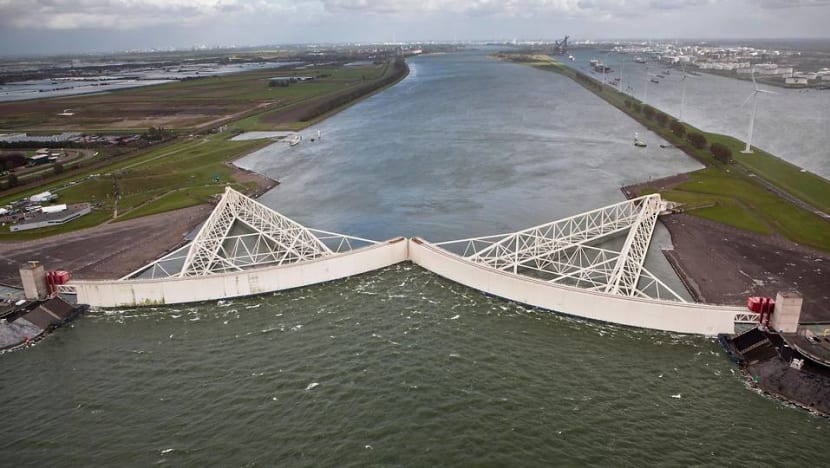Southeast Asian countries turn to the Netherlands for ways to tackle flood risks
The Dutch's experiments with floating buildings and coastal protection can serve to guide Southeast Asia’s bid to battle rising tides.

The Maeslantkering, or Maeslant Barrier, is giant sea gate that serves as the first line of defence for the city of Rotterdam. (Photo: Dutch Ministry of Infrastructure and Water Management)

This audio is generated by an AI tool.
ROTTERDAM: Some countries in the Southeast Asian region are turning to the Netherlands for ways to tackle rising tides and floods stemming from climate change.
The Dutch, which have decades of expertise in water management, hope to help reduce billions of dollars in costs spent on flood disaster systems and losses suffered by those affected.
Observers said the country’s experiments with floating buildings and coastal protection can help guide Southeast Asia’s bid to battle sea level rise.
NETHERLANDS’ FLOOD DEFENCE SYSTEM
Among the innovations used in the Netherlands is the Maeslant storm surge barrier located near the Port of Rotterdam, which has been guarding the southern coast for over 25 years.
The fully automated barrier shuts down on its own when the sea level rises above 1.5m, protecting the country where 40 per cent lies below sea level.
In 1991, it cost the Dutch government almost €500 million (US$540 million) to build the storm surge barrier, and another €10 million a year to maintain the structure.
The barrier forms part of the Netherlands' massive flood defence system to protect the low-lying delta region, where most of the Dutch population and economic activities lie.
The only other similar storm surge barrier in the world is in the Russian city of Saint Petersburg.
“The biggest concern is that our country is now 40 per cent floodable,” said Peter Persoon, technical information officer at the Keringhuis Public Water Center.
Preparations have led to the Netherlands being able to resist floods that are at most 5m above normal sea levels, he added.
“When sea levels increase, we have to adjust systems. It's okay for now, but you have to look out for the future. We are already planning what that will be for the year 2100.”
Despite the extensive network of dykes and dams as well as dunes along the coast, the Dutch flood defence system will not be able to withstand the tide if sea level continues to rise, he added.
“Even in our tiny country, we have to adjust 2000km of dykes, dams and dunes for the future.”
ASEAN'S COASTAL SETTLEMENTS AT RISK
Researchers are urging countries to take action to address flooding caused by unavoidable sea level rise.
In particular, Southeast Asia is at serious risk of losing infrastructure and low-lying coastal settlements.
“People think with climate change and sea level rise that they have plenty of time,” said Tjitte Nauta, regional manager for Asia and Oceania at Dutch applied knowledge institute Deltares.
“But this is the time to study it and to make the right decision. I would encourage ASEAN (the Association of Southeast Asian Nations) to move towards, indeed, more awareness, but also collaboration within the region. They can learn from each other, we can also learn from them.”
Thailand, Laos, Vietnam, Indonesia, and Malaysia are hotspots prone to flooding and coastal erosion.
“The whole city of Bangkok is extremely vulnerable,” said Nauta. “If 2m of relative sea level rise, some 28 per cent of the Thai population and 52 per cent of the GDP (gross domestic product) will be affected.
“So for Thailand, it should be very obvious to work on a long-term plan whether they make decisions of protecting the city or moving the city or whatever, but a study should already be there.”
In Indonesia, sea level rise has a profound negative impact on large swathes of low-lying peatland used for oil palm production.
Similarly in Vietnam, where agricultural output is important in the Mekong and Red River Delta, a 2m sea level rise will have a devastating effect on its people.
Malaysia’s coastal areas will not be spared either, according to satellite data.
Recently, Deltares set up an online platform and invited young diplomats from ASEAN to share their views on tackling climate issues.
“It’s very important to look at what the countries need, instead of us telling them you should do what we think you need to do,” said Josien Grashof, adviser on resilience and planning at Deltares.
“So by getting their ownership of this process, we can really work towards their highest priorities.”
Deltares highlighted problems plaguing some Southeast Asian countries, including the lack of funding and credible data for early warning systems, and differences in national priorities.


















